
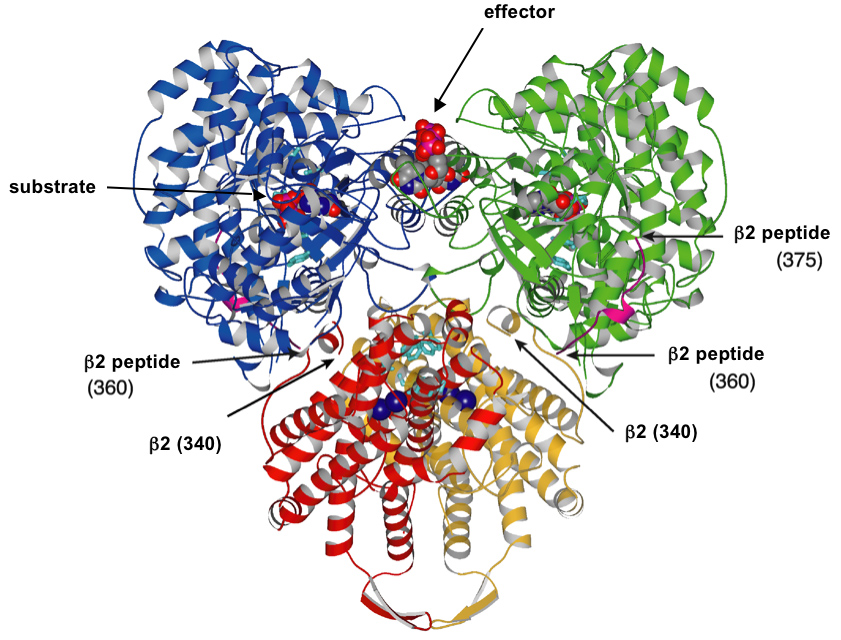
Current projects in the group include:
- Investigating the radical propagation pathway utilized by Class I RNRs through the use of unnatural amino acids using methodology developed by the Schultz lab (Scripps). (In collaboration with the Nocera lab.)
- Studying biosynthesis, activation, and regulation of Class I RNRs in E. coli and S. cerevisiae.
- Elucidating interactions between protein subunits of Class I RNR using photo-crosslinking.
- Examining regulation of RNRs: allosteric effetcs on subunit interactions, subunit localization, and tyrosyl radical concentration.
- Revealing mechanisms of clinically useful drugs: gemcitibine, hydroxyurea.
Postulated Proton-Coupled Electron Transfer Pathway in Class I RNR
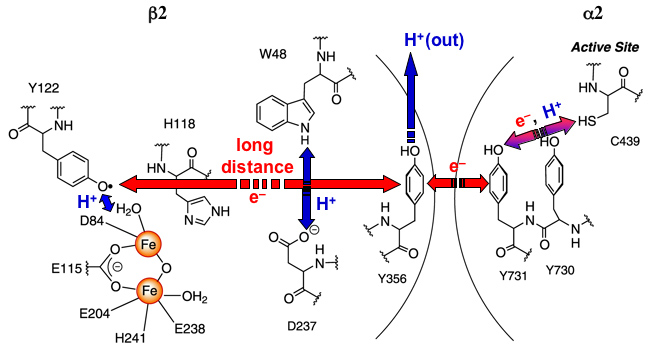

Proposed biosynthesis, activation, and regulation of RNR in E. coli
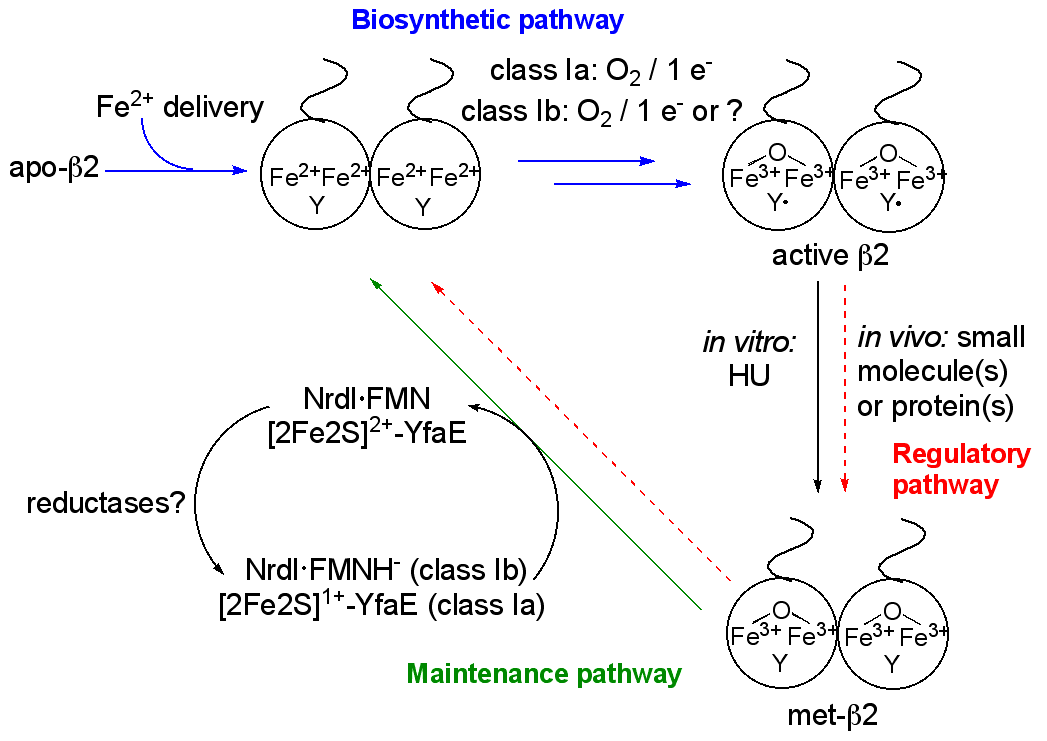


- Cotruvo, J.A.; Stubbe, J. An Active Dimanganese(III)-Tyrosyl Radical Cofactor in Escherichia coli Class Ib Ribonucleotide Reductase. Biochemistry Articles ASAP.
- Lohman, G.J.S.; Gerfen, G.J.; Stubbe, J. Inactivation of Lactobacillus leichmannii ribonucleotide reductase by F2CTP: adenosylcobalamin destruction and formation of a nucleotide based radical. Biochemistry Just Accepted.
- Lohman, G.J.S.; Stubbe, J. Inactivation of Lactobacillus leichmannii ribonucleotide reductase by F2CTP: covalent modification. Biochemistry Just Accepted.
- Shanmugam, M.; Doan, P.E.; Lees, N.S.; Stubbe, J.; Hoffman, B.M. Identification of Protonated Oxygenic Ligands of Ribonucleotide Reductase Intermediate X. J. Am. Chem. Soc. 2009, 131, 3370-3376.
- Artin, E,; Wang, J.; Lohman, G.J.S.; Yokoyama, K.; Yu, G.; Griffin, R.G.; Bar, G.; Stubbe, J. Insight into the Mechanism of Inactivation of Ribonucleotide Reductase by Gemcitabine 5'-Diphosphate in the Presence or Absence of Reductant. Biochemistry 2009, 48, 11622-11629.
- Wang, J.; Lohman, G.J.S.; Stubbe, J. Mechanism of Inactivation of Human Ribonucleotide Reductase with p53R2 by Gemcitabine 5'-Diphosphate. Biochemistry 2009, 48, 11612-11621.
- Reece, S.Y.; Lutterman, D.A.; Seyedsayamdost, M.R.; Stubbe, J.; Nocera, D.G. Re(bpy)(CO)3CN as a Probe of Conformational Flexibility in a Photochemical Ribonucleotide Reductase. Biochemistry 2009, 48, 5832-5838.
- Seyedsayamdost, M.R.; Stubbe, J. Replacement of Y730 and Y731 in the α2 subunit of Escherichia coli ribonucleotide reductase with 3-aminotyrosine using an evolved suppressor tRNA/tRNA-synthetase pair. Methods Enzymol. 2009, 462, 45-76.
- Seyedsayamdost, M.R.; Argirevic, T.; Minnihan, E.C.; Stubbe, J.; Bennati, M. Structural Examination of the Transient 3-Aminotyrosyl Radical on the PCET Pathway of E. coli Ribonucleotide Reductase by Multifrequency EPR Spectroscopy. J. Am. Chem. Soc. 2009, 131, 15729-15738.
- Zipse, H.; Artin, E.; Wnuk, S.; Lohman, G.J.S.; Martino, D.; Griffin, R.G.; Kacprzak, S.; Kaupp, M.; Hoffman, B.; Benatti, M.; Stubbe, J.; Lees, N. Structure of the Nucleotide Radical Formed during Reaction of CDP/TTP with the E441Q-α2β2 of E. coli Ribonucleotide Reductase. J. Am. Chem. Soc. 2009, 131, 200-211.
- Minnihan, E.C.; Seyedsayamdost, M.R.; Stubbe, J. Use of 3-Aminotyrosine To Examine the Pathway Dependence of Radical Propagation in Escherichia coli Ribonucleotide Reductase. Biochemistry 2009, 48, 12125-12132.
- Lee, Y.D.; Wang, J.; Stubbe, J; Elledge, S.J. Dif1 is a DNA-damage-regulated facilitator of nuclear import for ribonucleotide reductase. Molecular Cell 2008, 32, 70-80.
- Hassan, A.Q.; Stubbe, J. Mapping the subunit interface of ribonucleotide reductase (RNR) using photo cross-linking. Bioorganic & Medicinal Chemistry Letters 2008, 18, 5923-5925.
- Hassan, A.Q.; Wang, Y.; Plate, L.; Stubbe, J. Methodology to probe subunit interactions in ribonucleotide reductases. Biochemistry 2008, 47, 13046-13055.
- Cotruvo, J.A. Jr.; Stubbe, J. NrdI, a flavodoxin involved in maintenance of the diferric-tyrosyl radical cofactor in Escherichia coli class Ib ribonucleotide reductase. Proc. Natl. Acad. Sci. USA 2008, 105, 14383-14388.
- Hristova D.; Wu, C.-H.; Jiang, W.; Krebs, C.; Stubbe, J. Importance of the maintenance pathway in the regulation of the activity of Escherichia coli ribonucleotide reductase. Biochemistry 2008, 47, 3989-3999.
- Seyedsayamdost, M.R.; Xie, J.; Chan, C.T.; Schultz, P.G.; Stubbe, J. Site-specific insertion of 3-aminotyrosine into subunit α2 of E. coli ribonucleotide reductase: direct evidence for involvement of Y730 and Y731 in radical propagation. J. Am. Chem. Soc. 2007, 129, 15060-15071.
- Wang, J.; Lohman, G.J.S.; Stubbe, J. Enhanced subunit interactions with gemcitabine-5’-diphosphate inhibit ribonucleotide reductases. Proc. Natl. Acad. Sci. U.S.A. 2007, 104, 14324-14329.
- Wu, C.-H.; Jiang, W.; Krebs, C.; Stubbe, J. YfaE, a ferredoxin involved in diferric-tyrosyl radical maintenance in E. coli ribonucleotide reductase. Biochemistry 2007, 46, 11577-11588.
- Seyedsayamdost, M.R.; Yee, C.S.; Reece, S.Y.; Nocera, D.G.; Stubbe, J. pH rate profiles of FnY356-R2s (n = 2, 3, 4) in Escherichia coli ribonucleotide reductase: Evidence that Y356 is a redox-active amino acid along the radical propagation pathway. J. Am. Chem. Soc., 2006, 128, 1562-1568.
- Ortigosa, A.D.; Hristova, D.; Perlstein, D.L.; Zhang, Z.; Huang, M.; Stubbe, J. Determination of the in vivo stoichiometry of tyrosyl radical per ββ' in Saccharomyces cerevisiae ribonucleotide reductase. Biochemistry 2006, 45, 12282-12294.
- Stubbe, J.; Nocera, D.G.; Yee, C.S.; Chang, M.C. Radical initiation in the class I ribonucleotide reductase: long-range proton-coupled electron transfer? Chem. Rev. 2003, 103, 2167-2201.

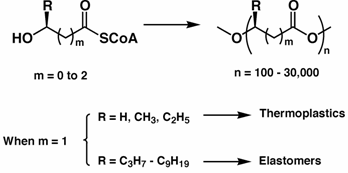
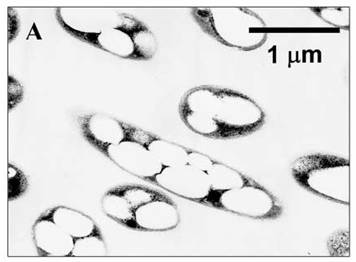
Tools we use in the PHB project:
- Pre-steady state kinetics
- Biochemical assays
- Organic synthesis
- X-ray crystallography
- Transmission electron microscopy
- Fluorescence microscopy
- Molecular biology

- Li, P., Chakraborty, S., & Stubbe, J. Detection of Covalent and Noncovalent Intermediates in the Polymerization Reaction Catalyzed by a C149S Class III Polyhydroxybutyrate Synthase. Biochemistry 2009 48, 9202-9211.
- Tian, J., Sinskey, A. J., & Stubbe, J. Kinetic studies of polyhydroxybutyrate granule formation in Ralstonia eutropha H16 by transmission electron microscopy. J. Bacteriol. 2005 187, 3814-3824.
- Tian, J., He, A., Lawrence, A. G., Liu, P., Watson, N., Sinskey, A. J., & Stubbe, J. Analysis of transient polyhydroxybutyrate production in Ralstonia eutropha H16 by quantitative western analysis and transmission electron microscopy. J. Bacteriol. 2005, 187, 3825-3832.
- Stubbe, J., Tian, J., He, A., Sinskey, A. J., Lawrence, A. G., & Liu, P. Nontemplate-dependent polymerization processes: polyhydroxyalkanoate synthases as a paradigm. Annu. Rev. Biochem. 2005, 74, 433-480.
- Stubbe, J. & Tian, J. Polyhydroxyalkanoate (PHA) homeostasis: the role of the PHA synthase. Nat. Prod. Rev. 2003, 20, 445-457.




